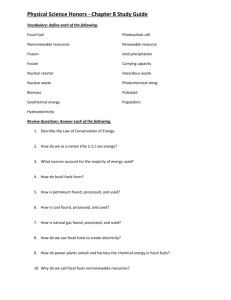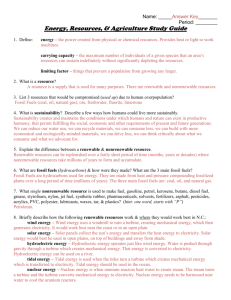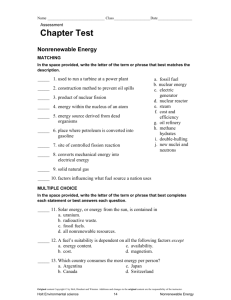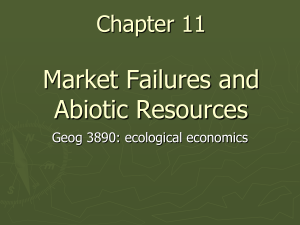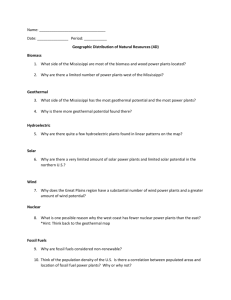STATION 1 ENERGY SOURCES Fossil fuels are nonrenewable
advertisement
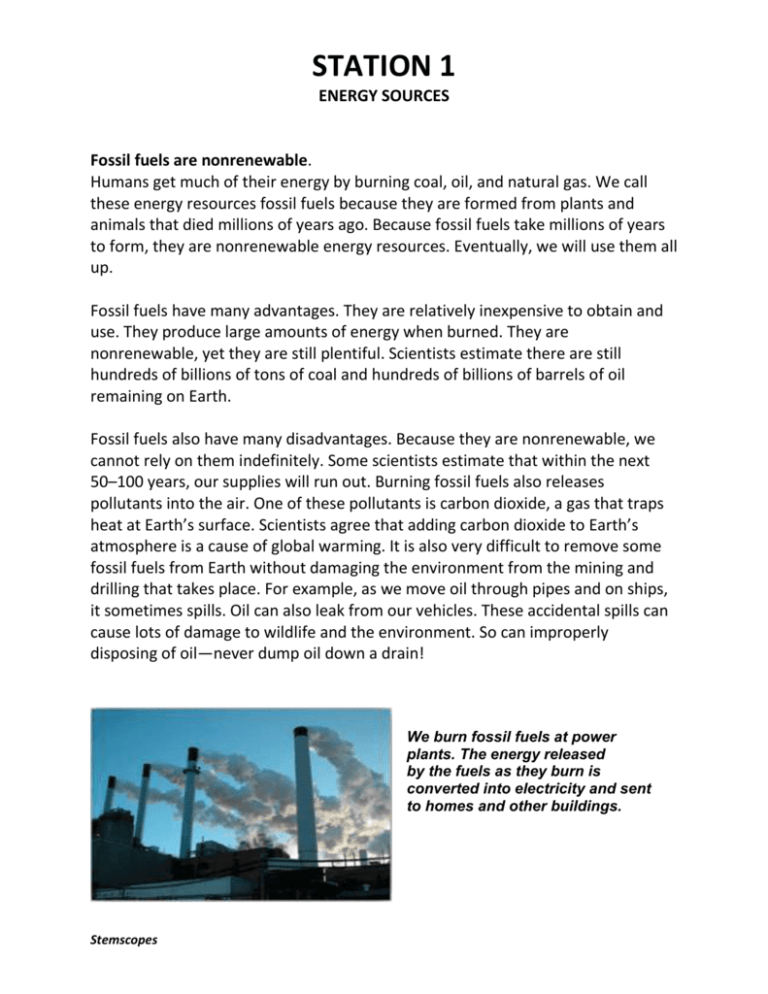
STATION 1 ENERGY SOURCES Fossil fuels are nonrenewable. Humans get much of their energy by burning coal, oil, and natural gas. We call these energy resources fossil fuels because they are formed from plants and animals that died millions of years ago. Because fossil fuels take millions of years to form, they are nonrenewable energy resources. Eventually, we will use them all up. Fossil fuels have many advantages. They are relatively inexpensive to obtain and use. They produce large amounts of energy when burned. They are nonrenewable, yet they are still plentiful. Scientists estimate there are still hundreds of billions of tons of coal and hundreds of billions of barrels of oil remaining on Earth. Fossil fuels also have many disadvantages. Because they are nonrenewable, we cannot rely on them indefinitely. Some scientists estimate that within the next 50–100 years, our supplies will run out. Burning fossil fuels also releases pollutants into the air. One of these pollutants is carbon dioxide, a gas that traps heat at Earth’s surface. Scientists agree that adding carbon dioxide to Earth’s atmosphere is a cause of global warming. It is also very difficult to remove some fossil fuels from Earth without damaging the environment from the mining and drilling that takes place. For example, as we move oil through pipes and on ships, it sometimes spills. Oil can also leak from our vehicles. These accidental spills can cause lots of damage to wildlife and the environment. So can improperly disposing of oil—never dump oil down a drain! We burn fossil fuels at power plants. The energy released by the fuels as they burn is converted into electricity and sent to homes and other buildings. Stemscopes STATION 2 ENERGY SOURCES Nuclear power is a nonrenewable energy source. All matter is made up of tiny particles held together by forces called bonds. Humans can break these bonds to release large amounts of energy called nuclear power. One of the most important advantages of Between 15 and 20% of the world’s nuclear power is that it does not produce electricity is produced at nuclear power plants. much air pollution or contribute to global warming. (Most of the gas released from a nuclear power plant is water vapor.) The fuel needed to produce nuclear power is relatively inexpensive, and it releases much more energy than fossil fuels. However, nuclear plants are expensive to build and maintain. Although they do not pollute the air, they produce large amounts of dangerous waste that is not easy to store or get rid of. Nuclear power is also nonrenewable—we use up the fuel more quickly than nature can make it. When some people think of nuclear energy, they remember terrible accidents that have happened at nuclear power plants. In 1986, a large nuclear power plant in Chernobyl, Ukraine, released dangerous materials into the surrounding environment. Many plants and animals—including people—died or were seriously injured. In 2011, an earthquake caused the release of dangerous materials at a nuclear plant in Fukushima, Japan. Nuclear power plants in the United States and other countries are regulated and inspected routinely. Still, the risk of terrible accidents causes some people to oppose nuclear energy. Nuclear power plants are dangerous because they contain radioactive materials. When a substance is radioactive, its particles are breaking apart. These particles can damage nearby organisms. Stemscopes STATION 3 ENERGY SOURCES Renewable energy resources can replace nonrenewable ones. In the United States, we use many more nonrenewable energy resources than renewable ones. In the past few years, energy use from several renewable energy resources has greatly increased. Let’s take a look at some of the most commonly used renewable energy resources. Solar Power: Sunlight is probably the most important energy resource on Earth. It warms the planet and provides plants with the energy they need to make food. Humans can also use sunlight to heat buildings and power machines. Today, many scientists are working to find more and better uses for solar power. Unlike most energy sources, solar power does not produce air or water pollution. Although the Sun shines only part of the time, batteries allow us to store solar energy to use later. However, solar panels are expensive. The process of making them can produce harmful waste, and old solar panels can be difficult to safely dispose of. This solar panel collects and stores sunlight. The energy is then used to power this streetlight. Stemscopes STATION 4 ENERGY SOURCES Geothermal: The Sun is Earth’s main source of energy. However, our planet also produces its own energy deep beneath the surface. We call this geothermal energy. (Geo means “Earth” and thermal means “heat.”) Geothermal energy is a clean energy source that produces little waste. Geothermal plants are relatively inexpensive to run, and they can generate power around the clock. However, the initial cost of building a geothermal plant is high, and they can exist only where lots of Earth’s heat rises to the surface—like near hot springs or geysers. Additionally, geothermal energy is not easy to transport Some geothermal energy comes from warm water and rock near Earth’s surface. Other energy comes farther down, from extremely hot, molten rock (magma). Stemscopes STATION 5 ENERGY SOURCES Hydropower: Hydroelectric plants use the energy of flowing water as it moves downstream. (Hydro-means “water.”) The water spins turbines to produce electricity. Dams are often built near hydroelectric plants. The dams control the flow of water—the dams can be shut off if power is not needed. Hydropower is a clean energy source that does not pollute the environment. Yet, dams are expensive to build and maintain. They can cause flooding and disrupt the surrounding ecosystem by slowing or even stopping the flow of water in a river. In addition, power plants sometimes release heated water back into the ecosystem. Plants and animals living downstream of the dam may not be able to adapt to these changes. This dam on Lake Travis produces hydroelectric power in central Texas. Stemscopes STATION 6 ENERGY SOURCES Wind: Like flowing water, blowing air can spin turbines to produce electricity. These energy resources convert the motion, or kinetic energy, of natural processes into electrical energy we can use. Also like hydropower, using wind energy does not produce pollution. However, wind turbines can be noisy and expensive to build. As they spin in the air, they can harm birds flying nearby. Blowing air moves these windmills, or turbines. As the turbines move, they generate electricity. Biomass: Biomass refers to living or recently living organisms we can use as energy resources. For example, corn plants are converted into a fuel called ethanol that can replace gasoline in cars. Biomass is a cheap resource that can be made from many common waste products. Unlike fossil fuels, biomass is renewable—we can grow new plants quickly. However, burning biomass releases several harmful pollutants into the air. It also releases less energy than burning the same amount of fossil fuels. Stemscopes What do you know? Study the photographs of the energy resources below. Identify each energy resource as renewable or nonrenewable. Then, list two advantages and two disadvantages for each resource. Stemscopes

